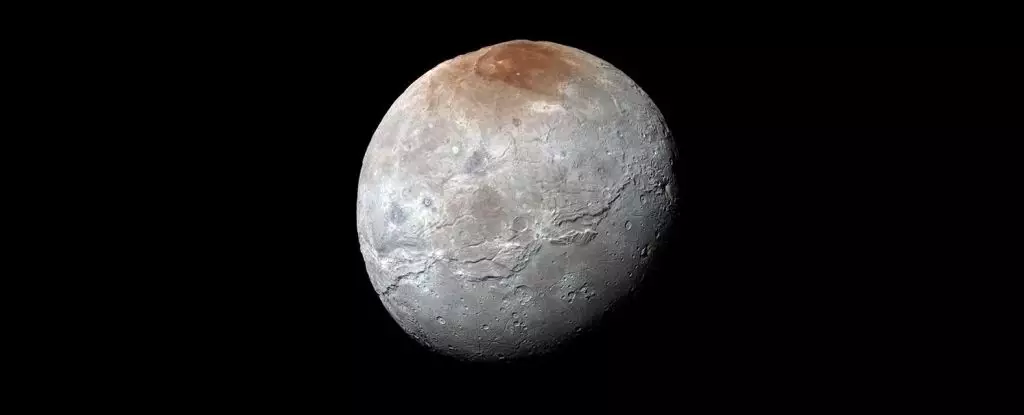The relationship between Pluto and its moon Charon is a captivating puzzle that has intrigued astronomers and planetary scientists alike. For centuries, the origins of this icy duo remained steeped in mystery, often clouded by the complexities of celestial mechanics. A new study introduces a novel concept termed “kiss and capture,” proposing that these celestial bodies experienced a transient fusion before assuming their current orbital patterns. This hypothesis not only diverges from traditional theories but also highlights the intricate and often unexpected processes that govern planetary formation.
Previously, most theories posited that Charon’s formation was the product of a substantial collision—akin to the event that is believed to have birthed Earth’s Moon. Yet, Adeene Denton, a planetary scientist at the University of Arizona, suggests that the relationship between Pluto and Charon was more delicate than previously imagined. The notion of a single catastrophic event has given way to the possibility of a softer, more complex interaction. The study casts doubt on the “hit and run” or “graze and merge” scenarios commonly discussed in planetary science, instead opening the door to the idea that Pluto and Charon intertwined briefly before parting ways, yet remaining gravitationally bound.
Understanding Pluto and Charon’s origins requires examining the environmental conditions in which these celestial bodies formed. The models that successfully explain the Earth-Moon dynamic are less effective beyond the Solar System’s frost line, where temperatures plummet and materials solidify. Pluto, with a diameter of approximately 2,376 kilometers (1,476 miles), and Charon, at about 1,214 kilometers, are uniquely positioned to challenge existing paradigms. Their colder, rocky-icy compositions alter the expected outcomes of collisional dynamics.
Denton and her team realized that the physical properties of Pluto and Charon allow them to maintain structural integrity during such encounters, in stark contrast to the warm, fluid-like behavior of Earth and its Moon. The implications are profound; rather than colliding with catastrophic disruption, the understanding is that these two celestial bodies coalesced in a gentler manner. This idea resonates with similar findings concerning the contact binary structure observed in distant Solar System objects, which allows us to revisit the life stories of these bodies.
To substantiate their hypothesis, the researchers employed simulations that revealed remarkable alignment with the observed orbital dynamics of Pluto and Charon. The models suggested a sequence of events in which the two bodies connected, endured a brief intimate phase, and then efficiently separated, all while maintaining their distinct identities. This captures the essence of their current orbit—an elegant waltz around a common center of gravity, where gravitational binds reign supreme.
Erik Asphaug of the University of Arizona emphasized the significance of this approach, stating that discovering parameters that accommodate Charon’s capture while defining its orbit is indeed a dual triumph. With the corroborating simulation results, the study reaffirms the nuanced and captivating nature of planetary formation, revealing it to be a tapestry woven from diverse and intricate cosmos characteristics rather than mere linear processes.
The study not only enriches our understanding of Pluto and Charon’s formation but also invites us to ponder how these initial conditions might shape geological evolution. As scientists continue to untangle the threads of Pluto’s history, this research could illuminate previously hidden pathways of its geological and atmospheric evolution. The relationship between the two bodies is likely dynamic, with Charon exerting influence over Pluto’s geology, including tectonic activity and surface characteristics.
Moreover, the findings encourage a reevaluation of how celestial objects interact with one another and how their histories inform their present states. Understanding the delicate balance of these interactions may shine a light on the processes that govern not only our Solar System but also those in distant galaxies and star systems.
Ultimately, the discovery of the “kiss and capture” dynamic encourages a more profound appreciation for the complexities of cosmic interactions. It challenges researchers to consider the full array of physical properties and dynamic processes at play, which can influence the trajectories of planetary bodies across vast time scales. By illuminating the nature of Pluto and Charon’s relationship, this research provides a fresh lens through which to appreciate the diversity of planetary evolution, paving the way for future inquiries that could unravel the ever-deepening mysteries of our Universe.

